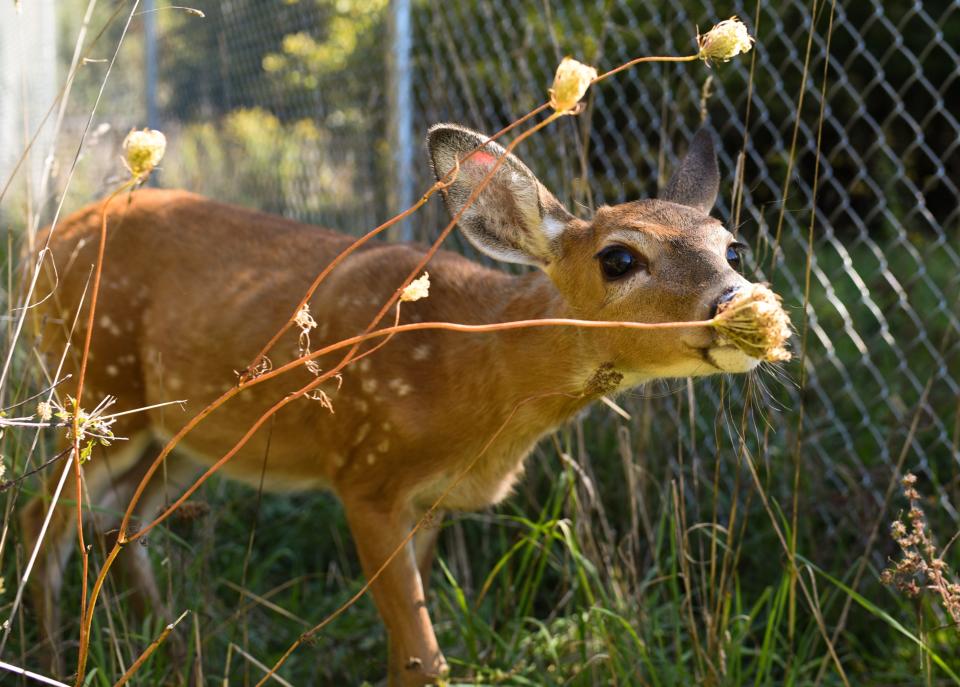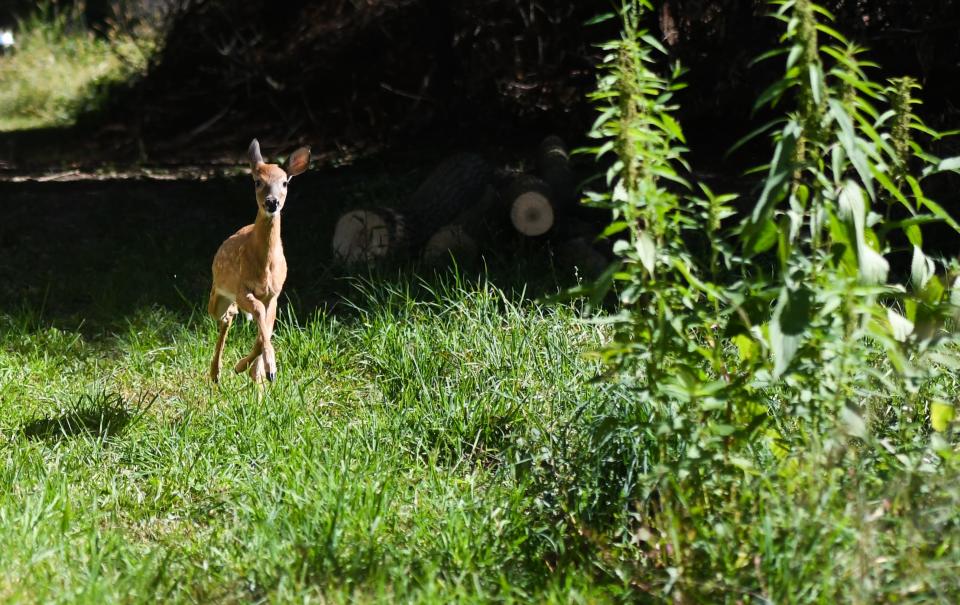Why this Bath Twp. wildlife center released 15 fawns into the wild
BATH TWP. — Little tongues licked little noses as 15 frivolous fawns frolicked, nibbled on tall grass and sheltered in their “Fawn Haven” sanctuary.
It wasn’t a Disney movie; the scene unfolded on Cheryl Connell-Marsh's property Tuesday afternoon where she released the animals she’s fawned over the past couple months.
“I love it because it’s what they’re supposed to be,” she said. “But now I’m sad, right?”
Connell-Marsh operates Nottingham Nature Nook, a licensed rehabilitation facility that handles mammals and non-federally regulated birds. It specializes in foxes and deer, euthanasia, and advice, according to the Michigan Department of Natural Resources.
Connell-Marsh has been rescuing fawns and other wildlife since 2013. Every October she releases rescued fawns into the wild, as required by the DNR's Wildlife Conservation Order.
The early October release is important so the fawns have time to acclimate to the wild before winter, DNR Wildlife Division Permit Specialist Casey Reitz said in an email.
“We want them to be able to learn (to) forage before food production begins to diminish," Reitz said. "Releasing them in the late fall lowers their chance of survival due of the lack of food resources available.”
Does usually give birth and start raising their fawns in late May and early June, according to the DNR.
Fawns that arrive at the Bath Township center can be very dehydrated and emaciated, have broken bones, and be in critical condition. Last year, Connell-Marsh was able to save and release 18 of 50 fawns she received.
She names the fawns, with monikers like Cinderella and Pongo.
Connell-Marsh was sure Cinderella and Pongo were among the several deer wandering the property as she released this year's group of fawns.

This year she named the deer after national parks, including Sequoia, Bryce (Bryce Canyon), Royale (Isle Royale) and Joshua (Joshua Tree). Yellowstone, in particular, stuck close to Connell-Marsh during the release, occasionally nibbling on the corner of her jacket.
Connell-Marsh described the fawns as her little flock of sheep, and they sounded like it, too, with soft bleats every now and again. Some were a little skittish, and chose to remain in the pen named “Fawn Haven” at first while others followed Connell-Marsh into a field, their ears and tails twitching.
She spends hours, all afternoon sometimes, with the deer on release day. She can’t put food out for them after the release, per regulations, but they do often stick close by, bedding on her property.
Connell-Marsh saves all sorts of animals: foxes, songbirds, squirrels. But fawns are different.
“They're just so kind and gentle,” she said.

She wishes people could see the relationships that develop between the animals and hopes people understand why she’s so involved in trying to prevent culls from happening in her area.
U.S. Department of Agriculture biologists trained in firearms have removed deer in East Lansing the past two years under a DNR permit. The culling area included the aquatic center and complex, less than a mile from Nottingham Nature Nook at 16848 Towar Ave.
East Lansing reduced the deer population, in part, because the city averages more than 40 deer-vehicle crashes per year within city limits and the deer population continues to grow. All venison from removals was donated to the Greater Lansing Food Bank, according to the city's website.
Connell-Marsh said if she were to tranquilize the fawns and move them somewhere else, it would be very hard on them. And, she asked, why should she?
“This is it, this is nature guys,” Connell-Marsh said. “You don’t get to pick and choose.”
Contact Bryce Airgood at 517-267-0448 or bairgood@lsj.com. Follow her on Twitter @bairgood123.
This article originally appeared on Lansing State Journal: Nottingham Nature Nook releases 15 fawns into the wild in Bath Township
